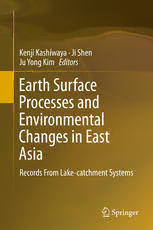
Earth Surface Processes and Environmental Changes in East Asia: Records From Lake-catchment Systems PDF
Preview Earth Surface Processes and Environmental Changes in East Asia: Records From Lake-catchment Systems
Kenji Kashiwaya · Ji Shen Ju Yong Kim Editors Earth Surface Processes and Environmental Changes in East Asia Records From Lake-catchment Systems Earth Surface Processes and Environmental Changes in East Asia Kenji Kashiwaya • Ji Shen (cid:129) Ju Yong Kim Editors Earth Surface Processes and Environmental Changes in East Asia Records From Lake-catchment Systems 123 Editors KenjiKashiwaya JiShen KanazawaUniversity NanjingInstituteofGeography Kanazawa,Japan andLimnology Nanjing,China JuYongKim KoreaInstituteofGeoscience andMineralResources(KIGAM) Daejeon,Korea ISBN978-4-431-55539-1 ISBN978-4-431-55540-7 (eBook) DOI10.1007/978-4-431-55540-7 LibraryofCongressControlNumber:2015941285 SpringerTokyoHeidelbergNewYorkDordrechtLondon ©SpringerJapan2015 Thisworkissubjecttocopyright.AllrightsarereservedbythePublisher,whetherthewholeorpartof thematerialisconcerned,specificallytherightsoftranslation,reprinting,reuseofillustrations,recitation, broadcasting,reproductiononmicrofilmsorinanyotherphysicalway,andtransmissionorinformation storageandretrieval,electronicadaptation,computersoftware,orbysimilarordissimilarmethodology nowknownorhereafterdeveloped. Theuseofgeneraldescriptivenames,registerednames,trademarks,servicemarks,etc.inthispublication doesnotimply,evenintheabsenceofaspecificstatement,thatsuchnamesareexemptfromtherelevant protectivelawsandregulationsandthereforefreeforgeneraluse. Thepublisher,theauthorsandtheeditorsaresafetoassumethattheadviceandinformationinthisbook arebelievedtobetrueandaccurateatthedateofpublication.Neitherthepublishernortheauthorsor theeditorsgiveawarranty,expressorimplied,withrespecttothematerialcontainedhereinorforany errorsoromissionsthatmayhavebeenmade. Printedonacid-freepaper SpringerJapanKKispartofSpringerScience+BusinessMedia(www.springer.com) Preface We may be faced with natural and anthropogenic environmental changes never found in instrumental observation records, not only locally but also globally. Generally, it is comparatively easy to find the cause and effect of local and short- termchanges,whereasitisdifficulttoestablishcausalrelationshipsforglobaland long-termenvironmentalissues.Oneofthemostsignificantissuesinenvironmental changestobediscussedisknowinghowearthsurfaceenvironmentsrespondedtothe changesinthepast,becausethatknowledgeisrequiredinordertoestimatefuture environmentalresponsestochanges.Wehaveonlylimitedshort-termobservational data in the instrumental observation period to provide some clues to find causal relations for the estimation. Most areas lack past quantitative records, especially dataavailableforquantitativediscussion,althoughdataonearthsurfaceresponses tolargeandlong-termglobalchangesareincludedinpastproxyrecords. One of the attempts to overcome this situation is to establish studies on lake- catchment systems (e.g., limno-geomorphology). The systems may provide a key to understanding cause and effect in past environments, because current sediment information can be compared with present observations in the systems (process understanding); environmental information, especially having to do with catch- ments, may be causally connected with observational data. Lacustrine sediments of the systems are recording media, and phenomena that occurred in the systems arerecordedinthemedia.Comparativelyshort-termlake-catchmentprocessesand process-recording mechanisms are clarified mainly with instrumental observation. The time interval and precision of recorded data depend on the length of the recordingmedia(thicknessofsediments)andresolution(sedimentationrate).These instrumental observation and high-resolution records fundamentally provide clues to clarify past processes and reconstruct past changes, and they will furnish ideas forpredictingfuturechangesaccordingtothedatalengthandprecision. A goal of this book is to make clear the relations among climato-hydrological changes, land use, natural disasters, and so on during the recent (geological) past, especiallyintheperiodsofrapidenvironmentalshifts(rapidglobalwarming,rapid global cooling, rapid tectonic movement, and others), by using lake-catchment systems in northeast Asia from Mongolia to Taiwan. Northeast Asian districts, v vi Preface locatedinthemiddlelatitudinalzone,arenotonlyaffectedbywesterlycirculation butalsocontrolledbyEastAsianmonsoons.Inwinter,thecoldsurge,whichsweeps eastern Asia, usually breaks out around Siberia and Mongolian areas. In summer, the Asian summer monsoon flowing through Japan and Korea can reach northeast Chinaaswell.Inspring,largeamountsofaeoliandust(loess)duetothewesterlies are transported to northeast China, Korea, and Japan from central Asia and west China.Therefore,climatesandenvironmentsofthesedistrictsarecloselyrelatedto oneanother.Thedistrictsareundersimilarclimaticconditionswithsomesystematic differencesinclimaticfactors(temperature,precipitation,etc.),tectonicfactors,and anthropogenic factors. This means that both proxy and observation data may be availablefortheEastAsiancountriesinviewoftheirownuniqueprovisionaswell ascommondataassociatedwithdisastersandclimato-hydrologicalevents. Thesystemsdiscussedareofvariousorigin:lava-flowdammedlakes,e.g.,Terhin Tsagaan Lake (Mongolia) and Jingpo Lake (northeast China); a volcanic debris- flow dammed lake, e.g., Lake Onuma (Japan); tectonic lakes, e.g., Xinkai Lake (northeastChina),LakeBiwa(Japan),LakeYogo(Japan),QiluLake(southChina), and Ri-yue-tan (“Sun-Moon Lake”) (Taiwan); coastal lagoons, e.g., Hwajinpo (Korea),Songjiho(Korea),Bongpo(Korea),Cheonjinho(Korea),Ssangho(Korea), and Soonpogaeho (Korea); artificial reservoirs, e.g., Eurimji (Korea) and Kobe Kawauso-ike (Japan). Especially Xinkai Lake, Jingpo Lake, Eurimji, and Lake Onuma are common targets of joint research among Kanazawa University, the Nanjing Institute of Geography and Limnology, and the Korea Institute of GeoscienceandMineralResources. Allthesystemsselectedherehavevaryingtimescalesofinformationonclimatic changesandenvironmentalchangesintherecentgeologicalpast,includingtectonic and anthropogenic activities in the area. We hope that the results contained here along withfurtherinformation onthesystemswillprovide valuable knowledge of pastenvironmentsandsignificantcluesforfuturepredictionandprovision. Allmanuscriptswerepeer-reviewedbymanydevotedreviewers.Inaddition,the editors were assisted in a variety of ways by many individuals and organizations during the editorial process. They especially wish to thank K.N. Cho, R. Chen, J.A. Dearing, N. Endo, H. Ganzawa, Y. Ge, N. Hasebe, T. Iida, M. Ji, K. Katsuki, C.Li,H.Long,J.Lim,W.K.Nahm,H.S.Park,H.Shimazu,W.Sun,H.Takahara, Y. Tanaka, K. Tanaka, Y. Tani, Y. Wang, J. Wu, X. Yang, M. Yoshimoto, and E. Zhang. The patience and assistance of the editorial staff of Springer Japan are highly appreciated. The financial support for research works from the Strategic InternationalResearchCooperativeProgramoftheJapanScienceandTechnology Agency (JST) and from the Japan Society for the Promotion of Science (Grants- in-AidforScientificResearch)aregratefullyacknowledged.Theseresearchworks were also supported by the National Basic Research Program of China (973 Pro- gram,2012CB956100)andtheCAS/SAFEAinternationalpartnershipprogramfor creativeresearchteams(No.KZZD-EW-TZ-08).FundsfromtheNationalResearch Foundation of Korea and the financial support of both the Basic Research Project oftheKoreaInstituteofGeoscienceandMineralResources(KIGAM-15-3113)and the Radioactive Waste Management of the Korea Institute of Energy Technology Preface vii EvaluationandPlanning(KETEP-2012171020001B)wereinvaluableforsuccessful performanceoftheJapan–China–Koreajointresearchproject(2011–2013)andthis publication. Kanazawa,Japan KenjiKashiwaya Nanjing,China JiShen Daejeon,Korea JuYongKim February2015 Contents 1 Present Earth-Surface Processes and Historical EnvironmentalChangesInferredfromLake-CatchmentSystems ... 1 K.Kashiwaya, T.Okimura, T.Itono, K.Ishikawa, andT.Kusumoto 2 Centennial-Scale Environmental Changes in Terhiin Tsagaan Lake, Mongolia Inferred from Lacustrine Sediment:PreliminaryResults............................................ 25 KeisukeFukushi,NagayoshiKatsuta,RobertG.Jenkins, KosukeMatsubara, BuntaTakayama, YukiyaTanaka, DavaadorjDavaasuren,OchirbatBatkhishig,NorikoHasebe, andKenjiKashiwaya 3 OSL Chronology of the Sand Hills of Xingkai Lake, NortheastChinaandItsImplicationforEnvironmental ChangesSince200kyrBP................................................. 45 JiShen,YongWang,andYunZhu 4 Palaeoenvironment and Palaeoclimate Evolution of Northeast China: Based on Multi-proxy Analysis ofSedimentfromLakeXingkai........................................... 63 JiShen,MingJi,JianWu,andYongWang 5 Paleovegetation and Paleoclimate Evolution of Past 27.7calkaBPRecordedbyPollenandCharcoalofLake Xingkai,NortheasternChina.............................................. 81 MingJi,JiShen,JianWu,andYongWang 6 Reconstructing Mid- to Late Holocene East Asian MonsoonVariabilityintheJingpoLake,NortheasternChina........ 95 RongChenandJiShen ix
